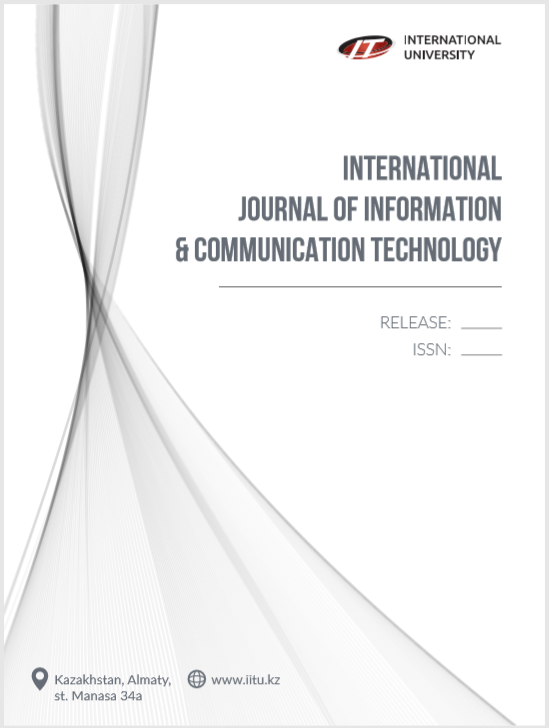
INTERNATIONAL JOURNAL OF INFORMATION AND COMMUNICATION TECHNOLOGIES
RULES FOR USING ARTIFICIAL INTELLIGENCE TOOLS WHEN WRITING SCIENTIFIC ARTICLES
This document sets out the rules for using artificial intelligence (AI) tools in writing scientific articles to ensure scientific activity's transparency, ethics, and reliability. Modern AI technologies provide researchers with new opportunities for data analysis, process automation, and increased productivity. However, their use requires strict adherence to academic standards and principles of scientific integrity. These rules guide the responsible use of AI, minimizing risks and maintaining high-quality scientific publications, helping to strengthen trust in research results and compliance with international and national norms and standards.
These guidelines aim to ensure transparency, ethics, and scientific correctness in using AI tools to prepare, write, and publish scientific articles and to establish procedures to help maintain high-quality scientific research.
Authors, the journal's editorial board, and reviewers are jointly responsible for following these guidelines. These guidelines will be reviewed and updated as AI technologies advance and new challenges in scientific endeavors emerge.
- Ethics of using AI tools
1.1 If AI tools are used for data analysis, writing, or other purposes, they must be openly disclosed in the scientific article.
1.2. The use of AI does not relieve authors from responsibility for the originality and accuracy of the material.
1.3. It is prohibited to use AI tools to manipulate data, falsify results, or distort information to exaggerate the significance of scientific research results.
1.4. The use of AI must not violate copyright, ethical standards, and principles of scientific integrity, including accidental duplication of text generated by AI.
- Transparency in the use of AI
2.1. Authors of a publication must indicate which AI tools were used in preparing the article and at what specific stage (e.g., text generation, data processing and analysis, image generation, etc.).
2.2. it must indicate which part of the work was performed by the authors and which was performed using AI.
2.3. The text of the article (e.g., in the Acknowledgments section) should include information describing the contribution of the AI to the research.
2.4. Any content created using AI must be verified and additionally checked by the authors to eliminate the risks of incorrect interpretation of data or context.
- Author's responsibility for the use of AI
3.1 Authors are fully responsible for all aspects of the publication (quality, reliability, ethics), including fragments created using AI.
3.2 AI tools should only be used as an auxiliary resource, not as a substitute for the author's contribution.
3.3. The authors must adapt and refine the results obtained using AI tools to ensure the research's uniqueness.
3.4 Authors must ensure that all licenses and copyrights associated with the use of AI are complied with.
3.5. The use of AI must not violate the regulatory acts of the Republic of Kazakhstan, laws on the protection of intellectual property, or the internal legal documents of the University.
- Checking the originality of publications
4.1. The editorial board of the scientific journal reserves the right to use specialized tools to check the uniqueness of publication texts, including analyzing data and facts created using AI.
4.2. The editorial board of the scientific journal reserves the right to request additional information on the use of AI tools during the expert assessment or review of the publication.
4.3. The editors of the journal reserve the right to reject an article if information about the use of AI tools has not been indicated.
4.4. If violations of the rules for using AI tools when writing a scientific article are detected, the editors of the scientific journal reserve the right to return the study for revision or refuse publication.
- Authorship of a scientific publication
5.1 Authorship should belong only to individuals who have made an intellectual contribution to the research and are willing to take responsibility for its content.
5.2. An AI cannot be listed as an author of an article because it does not have the rights and obligations of individuals and cannot interpret or bear responsibility for scientific results.
- Data privacy
6.1 Data protection regulations must be observed when using AI, especially when working with confidential or personal information.
6.2. The use of AI must comply with the requirements of international and national data protection standards.
- Recommendations for authors
7.1. AI tools can be used at the following stages of scientific publication preparation:
- literature search (automatic search, structuring and analysis of scientific publications, generation of annotations, summaries or summaries of articles on a selected topic);
- data analysis (processing large volumes of data, searching for patterns and identifying trends, using ML and DL methods to visualize and interpret data);
- assistance in describing and interpreting research results (generation of figures, graphs, tables, and diagrams based on research data; assistance in describing the results obtained by the authors, identifying directions for future research);
- formatting (automation of work with citations and bibliography, checking the structure of the article, the volume of the publication, and the templates used for compliance with the publisher's requirements);
- translation and editing of text (translation of a scientific article from one language to another while preserving the context and scientific terminology, unification of terms and formulations used in the text of scientific publications, correction of grammatical, spelling, and punctuation errors, improvement of the readability of the text, etc.).
7.2. It is prohibited to use AI tools to form scientific hypotheses and conclusions and output scientific results.
7.3 AI tools must not be used to circumvent ethical or methodological standards.
7.4. Examples of AI tools that can be used in publication work:
- ChatGPT, Jasper AI - for text generation and editing;
- EndNote, Zotero - for working with bibliography;
- Tableau, Python (pandas, matplotlib modules) - for data analysis and visualization;
- Grammarly, DeepL - for checking text and translation.
